Gas Facts
Gas Energy Australia compiles Gas Facts based on annual data. It is updated as authoritative facts, figures and research about gas production and use in Australia are published, citing fully attributed data from independent sources.
It is designed as a fast reference to national and state-by-state information about Australian gas. Scan key statistics about gas via the section titles in the menu (left) or by scrolling below...
Gas in the Economy
Australian gas is a mainstay of the national economy and is an irreplaceable ingredient for our manufacturing base, driving billions in economic activity through its myriad through-chain applications...
Gas in Australia generates $121.17 billion in economic activity - underpinning 5.25% of GDP. Up 42% on the previous year.
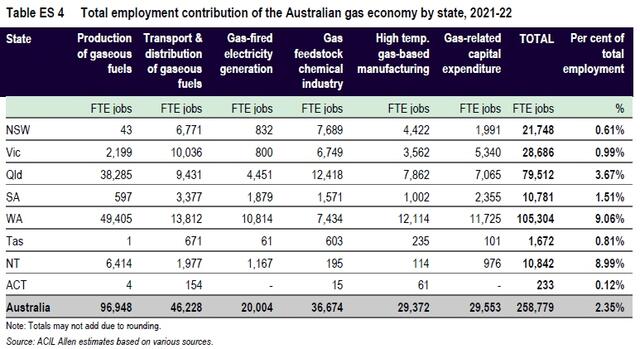
- ACIL Allen, Economic Contribution of the Australia Gas Economy in 2021-22, September 2023.
Australia's gas sector and its networks support 258,779 full-time local jobs - up 17,133 on the previous year.
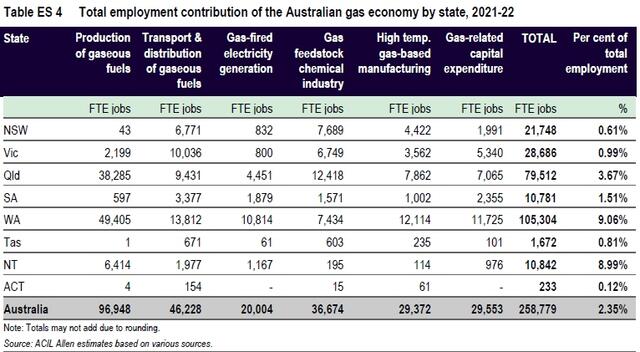
- ACIL Allen, Economic Contribution of the Australia Gas Economy in 2021-22, September 2023.
Gas production makes up the lion's share of the economic contribution of the gas supply chain to national domestic activity at $85.862 billion (up from $40 billion in the previous year), while supporting 96,948 Aussie jobs.
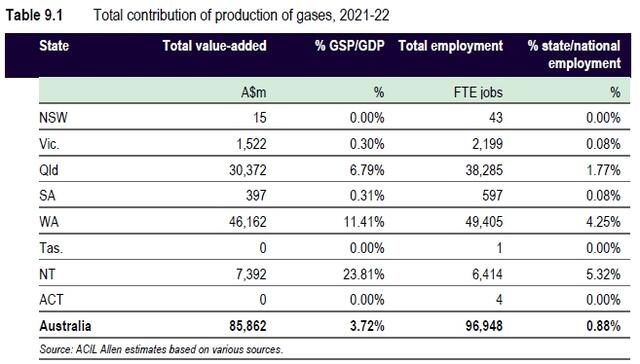
- ACIL Allen, Economic Contribution of the Australia Gas Economy in 2021-22, September 2023.
The transport and distribution of gas across Australia drives $10.22 billion (up from $8.1 billion the year before) in economic activity and supports 46,228 Aussie jobs (up almost 10,000 on the previous year).
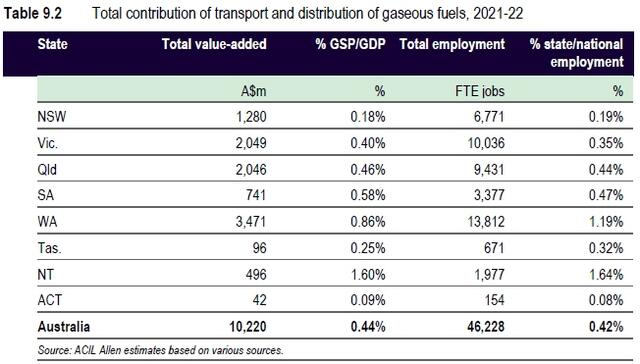
- ACIL Allen, Economic Contribution of the Australia Gas Economy in 2021-22, September 2023.
Gas-fired electricity generation in Australia provides $5.591 billion in economic activity (up $1.5 billion on the previous year) and supports 12,289 Aussie jobs (up over 7,700 on 2020-21). Importantly, as intermittent generating renewables (solar and wind) are more relied on as coal exists the market, gas will become increasingly relied upon to fill the inevitable downtime gaps.
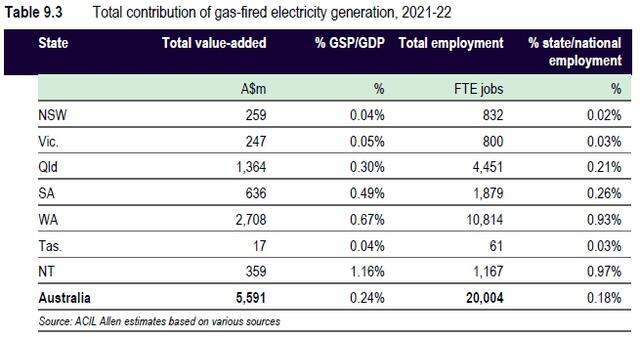
- ACIL Allen, Economic Contribution of the Australia Gas Economy in 2021-22, September 2023.
Through high temperature manufacturing, gas contributes $5.792 billion (up $700 million on the year before) in economic activity and support 29,372 Aussie jobs (up over 5,000 on 2021-22).
Gas is essential in generating industrial heat for manufacturing, including steel, glass, bricks, ceramics... to list a few. In this process it is irreplaceable given electricity, regardless of how it is produced, cannot generate the 800-1,300 degree Celsius temperatures required.
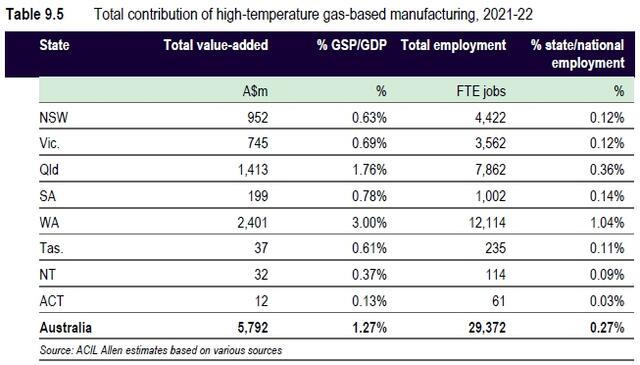
- ACIL Allen, Economic Contribution of the Australia Gas Economy in 2021-22, September 2023.
As a feedstock (or ingredient) in modern manufacturing, gas generates $7.538 billion to economic activity and supports 36,674 Aussie jobs (up 3,600 on the previous year).
Gas is a vital and irreplaceable feedstock in the making of many things we need for everyday life, including plastics, fertilisers, pharmaeuticals, rubber, propellants, refrigeration, adhesives, cosmetics. A more detailed is available in the 'Gas Use in Australia' section below.
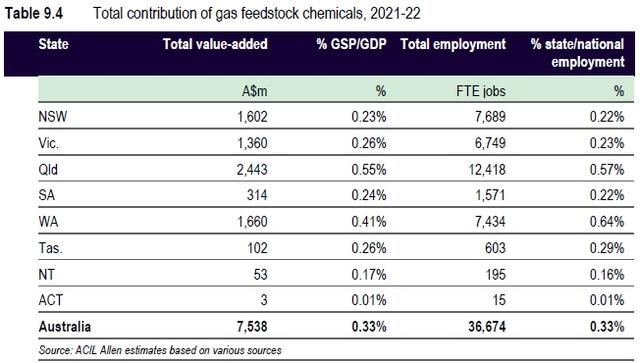
- ACIL Allen, Economic Contribution of the Australia Gas Economy in 2021-22, September 2023.
Gas-related capital expenditure, or the gas sector's investment in upgrading its operations, generates $6.169 billion (up over $1 billion on 2020-21) in domestic economic activity, supporting 26,285 Aussie jobs (up 3,268 on the previous year).
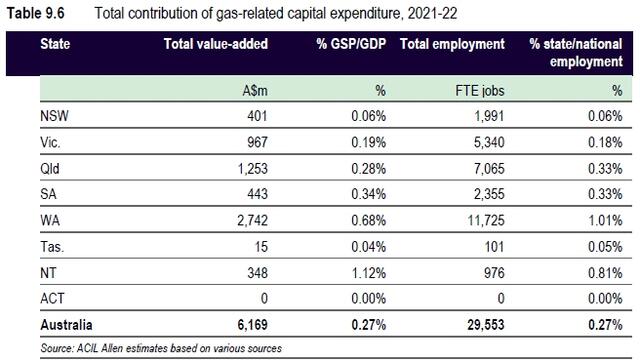
- ACIL Allen, Economic Contribution of the Australia Gas Economy in 2021-22, September 2023.
Some 130,000 businesses across Australia rely on gas for both industrial heat (to make steel, bricks, alumina, ceramics, etc) and as a feedstock (that is, as an ingredient in making plastics, chemicals, pharmaceuticals and fertilisers... to list just a few.
- Deloitte Access Economics analysis of Australian Bureau of Statistics data, March 2017.
Gas and Taxes
The gas Australia produces is a vital revenue raiser for government, underwriting government programs to deliver the essential services we all rely on...
Taxes, rates, fees and royalties from Australian gas yield $18.2 billion a year, supporting essentials services and infrastructure, such as hospitals, schools and roads across the country.
- AEAS, Economic and Employment Contribution of the Australian Gas Industry Supply Chain, 2020-21.
Gas Use in Australia
As individuals, and as a society, Australians today use gas not only in their homes but across a suite of applications that they don't even realise...
Almost 70% of Australian homes use mains or bottled gas for heating, cooking and hot water - that's 5.2 million households and growing by 100,000 per year.
- Frontier Economics, Gas Vision 2050: Delivering A Clean Energy Future, September 2020.
Overall, it is estimated that there are over 18 million residential gas appliances in use across Australia.
- Frontier Economics, Gas Vision 2050: Delivering A Clean Energy Future, September 2020.
Natural gas provides 44% of household energy, but produces just 13% of household greenhouse gas emissions.
- Deloitte Access Economics analysis of Australian Bureau of Statistics data, March 2017.
Around 2 million Australian homes use LPG indoors, which is supplied through virtual pipelines.
- Frontier Economics, Gas Vision 2050: Delivering A Clean Energy Future, September 2020.
GEA members supply more than 1.15 million Australian customers - businesses and households - excluding recreational and autogas customers.
- Australian Bureau of Statistics, Energy Use and Conservation, March 2014.
Australian Bureau of Statistics, Household and Family Projects, Australia 2011-2036.
Over 1 million households in regional areas of Australia use LPG in their homes, with more than 800,000 being utilised in capital cities.
- Gas Energy Australia, The Australian LPG Industry, September 2017.
Australia's gas infrastructure can store the same amount of energy as 6 billion Tesla Powerwall batteries.
- Deloitte Access Economics analysis of Australian Bureau of Statistics data, March 2017.
Gas provides around one-quarter (23%) of Australia's end-use energy consumption and, even by today's standards, is cleaner and more efficient in generating higher levels of renewable electricity.
- Frontier Economics, Gas Vision 2050: Delivering A Clean Energy Future, September 2020.
Most people know gas is used for heating in manufacturing. Only gas can achieve the extreme temperatures necessary for thermal energy used directly in the preparation or treatment of materials to produce manufactured goods. Electrification, regardless of its source, cannot achieve the very high temperatures, including over 1,300 degrees Celcius, demanded by modern industrial processes.
- Frontier Economics, Gas Vision 2050: Delivering A Clean Energy Future, September 2020.
It is little understood, but gas is a required feedstock (or ingredient) in making many of the things we take for granted, including:
- Plastics for mobile phones, toys, detergent bottles, milk bottles, eyewear, solar panels, wind turbines, life jackets, bandages, tents, shrink film, etc.
- Rubber, including for car tyres.
- Medical equipment, dental hygiene products.
- Pharmaceuticals.
- Propellants.
- Cosmetics.
- Agriculture, most notably fertilisers to increase crop yields, as well as pesticides, herbicides and a wide variety of farm chemicals, including in animal feed.
- Agricultural piping for irrigation and water storage.
- Packaging.
- Transport, especially heavy vehicles.
- Adhesives.
- Industrial piping for mining, commercial and housing - water, gas and other reticulation.
- Insect repellant.
- Artificial limbs.
- Musical equipment.
- Refrigeration for food storage.
- Anti-freeze for cars.
- Mechanical and auto-parts.
- White goods - appliances and electronics.
- Glass.
- Explosives.
- Soft drinks.
- Building products, medium density fibre board, particle board, insulation, flooring, siding and laminates.
- Water treatment for waste waters and sewage.
- Cleaning products, solvents, detergents, fabric softener, windshield cleaner and paint remover.
- Paper.
- Mining.
- Signage, glazing, lighting fixtures and surface coatings.
- Clothing and textiles, bedding and furniture, polyester, carpets and rugs.
- Hospitality - gas cooking for restaurants, cafes, bars and clubs, as well as outdoor heating.
- Entertaining - BBQs, outdoor heating, caravans and camping.
While by no means exhaustive, the list above demonstrates that gas is an essential component in providing the things that not only maker life enjoyable, but are vital for modern living.
- ACIL Allen Consulting, Chemical Industry Economic Contribution Analysis, Chemistry Australia, July 2019 and Energy Information Australia, 2021.
Overall, natural gas accounts for around 35% of energy consumption in Australian manufacturing. Gas energy is particularly important for certain industrial sectors and processes, in particular:
- For the production of high-temperature heat;
- For the generation of a flame, where industrial processes require direct exposure to flames;
- As a chemical feedstock (i.e. as an ingredient in the making of many products).
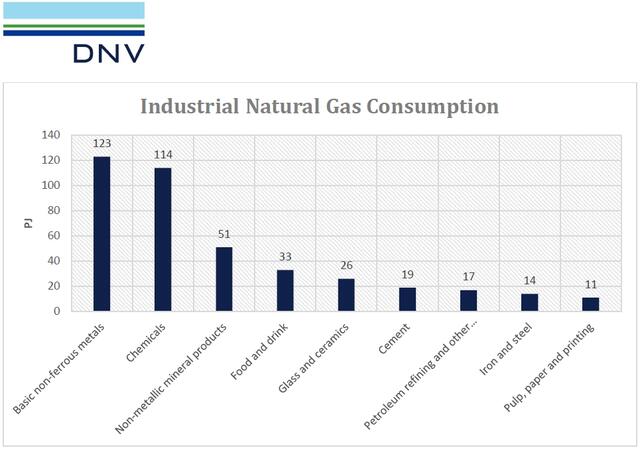
- DNV Australia, National Gas Decarbonisation Plan: Decarbonising Australia's Gas Pipelines and Networks, July 2021.
Over 18.1* million gas and LPG appliances, including barbeques, are in use across Australia, with more than 20 million** gas cylinders in circulation at any given time.
- *Frontier Economics, Gas Vision 2050, September 2020.
**GEA Member data 2022.
Gas infrastructure in Australia, traversing more than 40,000* kilometers of pipeline, as well as a network of over 20 million** cylinders plus tankers, delivers more energy in Australia than electricity. This existing network means cheaper gas, including renewable, net zero gases - for households and businesses.
- *Frontier Economics, Gas Vision 2050: Delivering A Clean Energy Future, September 2020.
**GEA Member data 2022.
Victoria is the largest user of gas in Australia, with 79% of homes using gas for cooking and heating to keep warm in winter.
- Frontier Economics, Gas Vision 2050: Delivering A Clean Energy Future, September 2020.
Research from Frontier Economics shows that replacing gas appliances in the home in Victoria will cost between $21,500 and $42,000 per dwelling.
- Frontier Economics, Cost of switching from gas to electric appliances in the home, 8 July 2022.
Victorians would have to save between $1,600 and $4,000 a year on their electricity bills to cover the cost of electrifying free-standing homes. This is a far cry from the Victorian Government's estimate of $1,025 to $1,250.
- Frontier Economics, Cost of switching from gas to electric appliances in the home, 8 July 2022.
By contrast, Victorians could save between $7,500 and $15,000 by retrofitting renewable gas ready appliances, rather than converting to electric appliances.
- Frontier Economics, Cost of switching from gas to electric appliances in the home, 8 July 2022.
Gas Research & Development
As a major contributor to Australia's economic, environmental and social wellbeing, the gas industry invests heavily in research, development and commercialisation to bring Australians the clean, reliable and affordable energy they expect...
The Australian gas industry invests $180 million annually in future fuels research projects, including Hydrogen and a raft of emerging renewable and net zero technologies.
- Frontier Economics, Gas Vision 2050: Delivering A Clean Energy Future, September 2020.
This plan is designed to deliver the three objectives that are needed to meet the net zero aim described in the Gas Vision 2050:
1. Enable blending of up to 10% by volume of renewable and decarbonised gases by 2030.
2. Enable 100% renewable and decarbonised gas supply to new residential developments before 2030.
3. De-risk a full network conversion to 100% renewable and decarbonised gases by 2050.
This work is actively underway.
- DNV Australia, National Gas Decarbonisation Plan: Decarbonising Australia's Gas Pipelines and Networks, July 2021.
